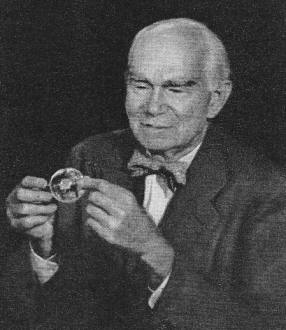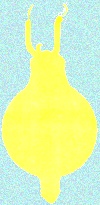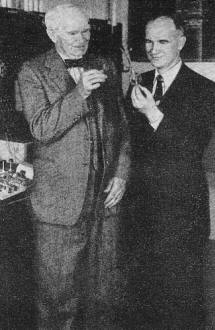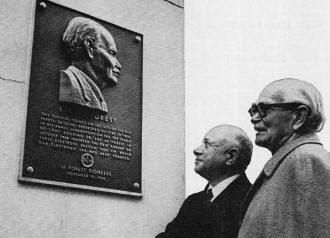Lee de Forest, Father of Radio, 1873-1961
|
|||||
The price of fame and fortune is often fraught with great tribulations and trials - literally. This eulogy of Audio vacuum tube inventor Lee de Forest which was written in 1961 by Radio-Electronics magazine editor Hugo Gernsback, summarizes many of the great accomplishments of the inventor / engineer, but does not mention the battles he fought both to protect his work from misappropriation by others and to defend himself from accusations of the same. All the industry greats - Edison, Armstrong, Tesla, Westinghouse, Noyce, Sarnoff, even Einstein - suffered similar experiences. Mr. Gernsback, a prolific inventor and publisher himself - was a good personal friend of Dr. de Forest, and featured his work often over more than three decades through his (Gernsback's) many trade magazines. A list of many of the articles is at the bottom of this page. If you are not familiar with the story of how de Forest arrived at his amplifying Audion tube, please read "How the Audion Was Invented. The journey began with the use of an open candle flame as a signal detector for CW (continuous wave) signals in wireless telegraphy. Interestingly, Mr. Gernsback deemed having a close-up photo of Dr. de Forest's hands was in important piece of the historical record. de Forest was just shy of 88 years old; Gernsback was 77 at the time. Lee de Forest, Father of Radio, 1873-1961
So passes a great historic era which ushered in not only radio but electronics as well. It was Dr. de Forest's vacuum tube - the Audion that lifted the whispering wireless-crystal-detector age into the radio-loudspeaker age, where it has remained ever since. No one doubts that the electronic age began in 1906 with his stupendous invention, which in turn gave us amplification, regeneration and oscillation, making possible the radiotelephone, broadcasting, radar, television and the host of other incredible electronic wonders already here, with new ones still in the future. Dr. de Forest inspects the newly invented transistor while Dr. Shockley, who directed the team responsible for its invention, holds one of the early Audions. Because his Audion - the first practical detector-amplifier - was one of the most brilliant and far-reaching inventions ever made, it fell to de Forest's unenviable lot to be constantly immersed in a long, fierce and costly series of patent litigations. So much was involved, not only in the US but in other countries as well, that everybody wanted to get into the act and share in the fabulous profits. The vacuum-tube gold rush was on. First of the contenders was Dr. J. A. Fleming of England with his two-element valve, which could neither amplify or regenerate. He had not even invented it, but had lifted it - without credit - in, toto from the real inventor. Edison had observed in 1883 the famed "Edison effect" which made it possible to send an electric current between a cold conductor and a hot filament in a vacuum. (To the credit of English scientists, Fleming a few years back was officially disowned as the inventor of the three-element de Forest vacuum tube, despite the long patent battle.) Then there were patent suits in behalf of German and French contenders, plus a long list of American litigants, among whom were Maj. Edwin H. Armstrong, inventor of the superheterodyne circuit as well as super-regeneration and the FM system now in increasing use and Dr. Irving Langmuir for the General Electric Co. The expensive, decades-long patent suits finally ended in 1934 in the US Supreme Court in a full victory for de Forest, who by that time had gone through at least four fortunes running into millions of dollars. In 1936, he went into personal bankruptcy, with considerable liabilities and assets of only $390. As is true of many inventors, de Forest had the misfortune of being associated with too many unscrupulous business managers and associates who looked out for themselves but not for him. Nor was he over much interested in business or money. His great urge in life was inventing. De Forest and Sarnoff before the plaque erected at the site of the invention of the vacuum tube. Fig. 1 - The earliest model of the flame or heat-operated detector. A prolific originator and inventor, he had well over 300 patents. Aside from his Audion and numerous vacuum-tube circuit patents, here are a few of the more outstanding ones: a tubeless (dynamic) amplifier, a gaseous microphone, a diffraction microphone, a subterranean signaling system, a cautery high-frequency surgery device (he was operated on with one several years before his death), a telegraphone. De Forest was intensely interested in loudspeakers - he invented many different types of various principles; a thermionic pickup; talking-picture devices; a thermophone, a diaphragmless speaker. A television sign operated by remote control and various television patents, including stereoscopic vision, large picture size and others, were also among his achievements. While de Forest, during his long and eventful life, had been honored with some eleven outstanding medals and decorations, including the recently awarded Cross of the Legion of Honor from the French Government, he was much disappointed that he never had been awarded the Nobel Prize. In private talks with this writer, the great inventor could not understand why Marconi should have been awarded the coveted prize while he, de Forest, with a much greater contribution in the arts, should not have been so honored. Accordingly, in March 1955, Radio-Electronics and the undersigned started a widespread campaign, petitioning the Nobel Fund, through the Swedish Academy of Science, in de Forest's behalf. Yet after the usual deliberation of the Fund, the result was negative. We were given to understand that the Nobel Prize in Science (physics) nowadays is given only for pure science, rarely for an invention. Unofficially we learned that there was not a sufficient number of votes for de Forest; certain individuals did not wish to vote because of their industrial affiliations in their respective countries. It became known, nevertheless, that the final voting was stormy. De Forest was heartbroken and stated so in a communication to us. The celebrated scientist-inventor, who saw his Audion blossom into a world-wide, multibillion dollar business, died in very modest circumstances after a long protracted illness that consumed all his life savings. As the undersigned stated in the January 1947, de Forest Anniversary Issue of this magazine, in a paraphrase of Winston Churchill: "Verily, never in the history of the world has so much been owed by so many to one man - Lee de Forest." - Hugo Gernsback
Posted April 19, 2021
|
|||||


 Lee De Forest, illustrious inventor of the Audion
tube, died on June 30 from a heart attack, at his home in Hollywood, Calif. He was
almost totally incapacitated since 1959 by an illness that kept him bedridden and
that was to last almost 2 years. His legion of friends will be comforted that he
died without suffering and in peace. His last signed letter to the present writer
- one of hundreds - was dated June 6, 1959.
Lee De Forest, illustrious inventor of the Audion
tube, died on June 30 from a heart attack, at his home in Hollywood, Calif. He was
almost totally incapacitated since 1959 by an illness that kept him bedridden and
that was to last almost 2 years. His legion of friends will be comforted that he
died without suffering and in peace. His last signed letter to the present writer
- one of hundreds - was dated June 6, 1959. 

